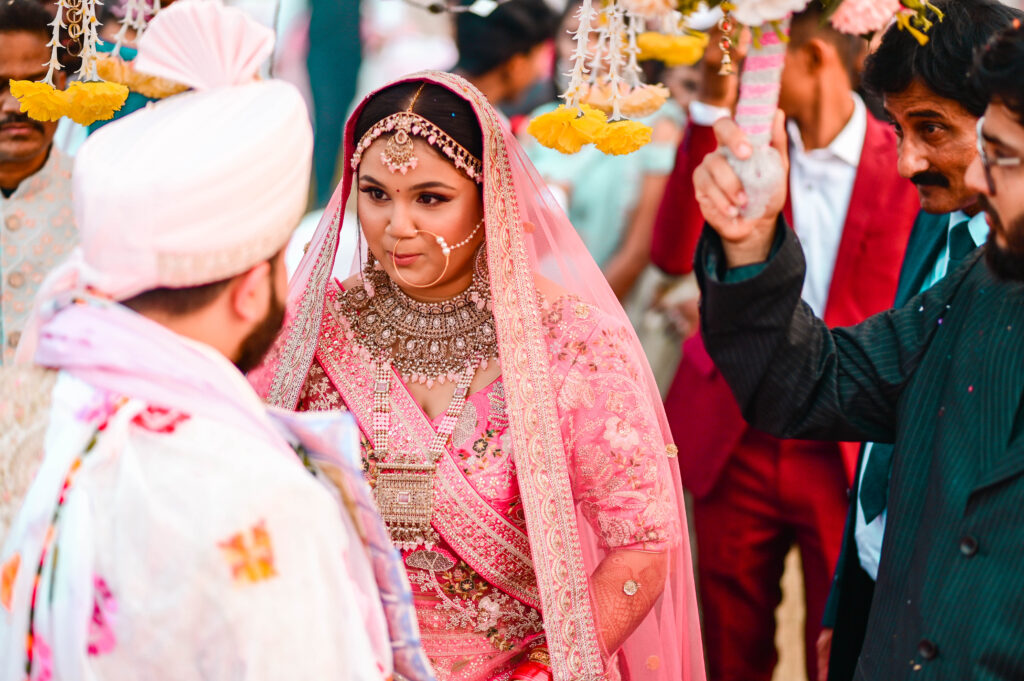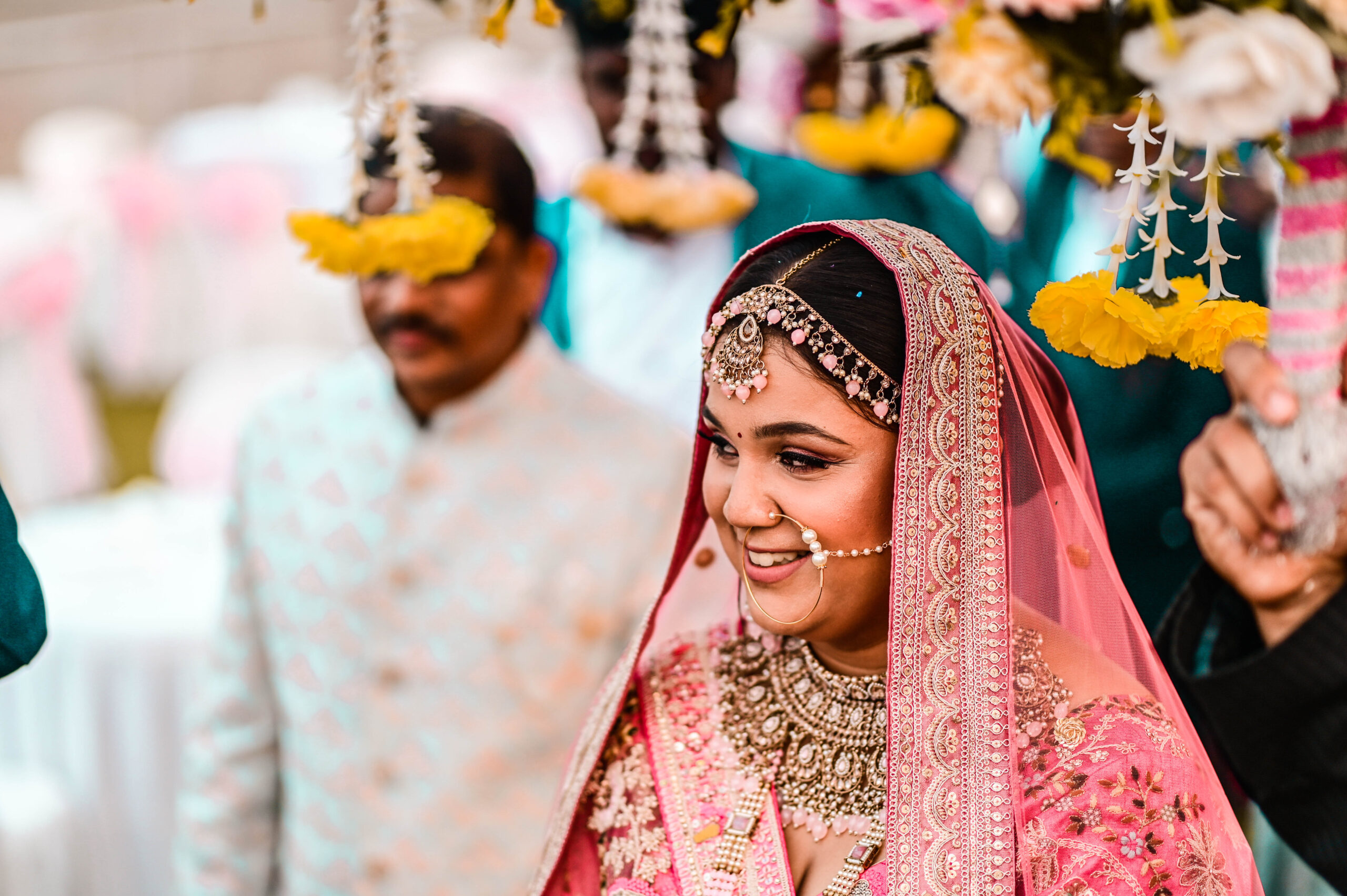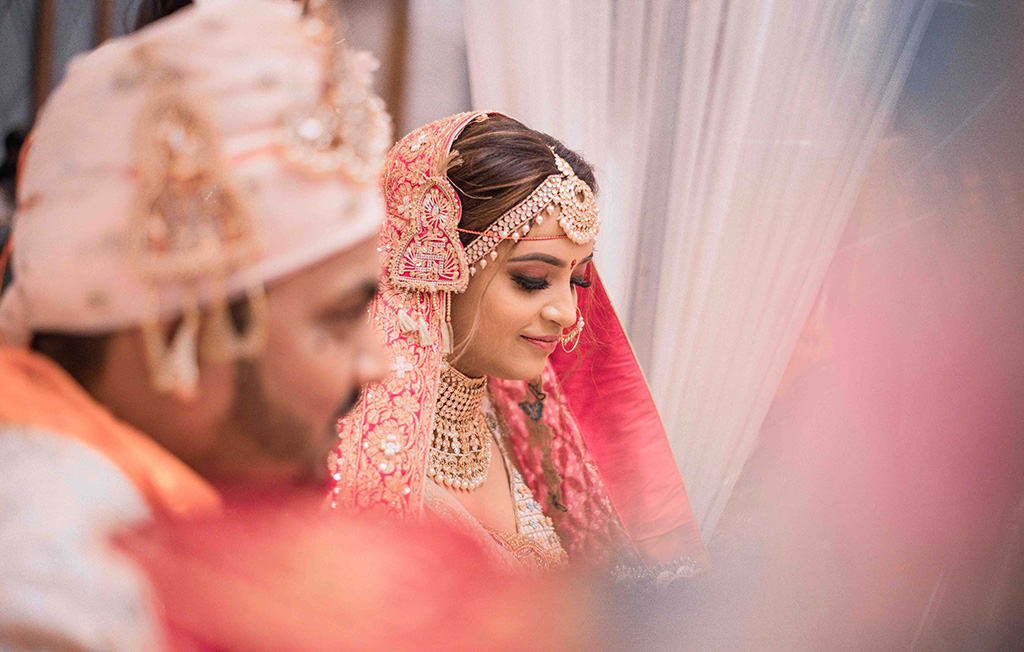wedding photography is an evolving art form, reflecting advancements in technology, changes in cultural expectations, and shifts in artistic trends. As couples demand increasingly personalized, immersive, and innovative ways to document their special day, the future of wedding photography promises exciting possibilities that go beyond traditional practices.
In this exploration of the future, we’ll discuss how emerging technologies, sustainability trends, creative storytelling, and global influences are shaping the future of wedding photography offering unique ways to preserve and relive cherished moments.
1. The Influence of Emerging Technologies
Artificial Intelligence (AI) in wedding photography
AI is already a game-changer, and its role will expand in the future:
- Image Selection: AI tools can analyze thousands of photos, choosing the best based on criteria like focus, composition, and emotional impact.
- Enhanced Editing: Automated retouching, color grading, and restoration tools will allow photographers to perfect images in a fraction of the time.
- Real-Time Feedback: Smart cameras integrated with AI may suggest optimal settings based on lighting, subject movement, or creative goals.
Augmented Reality (AR) and Virtual Reality (VR)
- AR Albums: Couples may use AR to bring their wedding albums to life, overlaying videos, animations, or soundtracks onto still images using mobile apps.
- VR Memories: Future wedding albums could be experienced in 360-degree VR, allowing couples to relive their wedding day as if they were there again.
Immersive 360-Degree Photography
Specialized cameras will capture panoramic views of ceremonies and receptions, offering a comprehensive and immersive storytelling format.
Smart Drones and Robotics
- Autonomous Drones: AI-powered drones will capture stunning aerial and dynamic shots without manual intervention.
- Robot Assistants: Robotic devices equipped with cameras could roam the venue, capturing candid moments discreetly.

2. Personalization and Customization
Hyper-Personalized Albums
The future will see a rise in highly customized photo albums:
- Interactive Elements: Embedded videos, voice messages, or written anecdotes will add emotional depth.
- Tailored Themes: Couples will have the ability to design albums that reflect their personality, cultural background, or wedding theme.
Pre-Wedding and Post-Wedding Shoots
Advanced technology will enhance themed engagement shoots and post-wedding storytelling sessions, offering cinematic narratives tailored to the couple’s journey.
Real-Time Social Media Integration
- Live Edits: Photographers may offer real-time editing and posting of select photos during the event for immediate social media sharing.
- Dynamic Hashtags: Event hashtags linked to curated photo galleries will enhance the digital wedding experience.
3. Sustainability in wedding photography
Eco-Friendly Equipment
- Energy-Efficient Cameras and Lights: Devices with lower power consumption will align with the increasing demand for sustainable practices.
- Recycled Materials: Photographers may use albums made from recycled or biodegradable materials.
Digital-Only Deliveries
Many couples are opting for digital-only photo and video deliveries to reduce waste, a trend that is likely to grow. Online galleries and cloud storage platforms will dominate the delivery process.
Minimizing Carbon Footprints
wedding photography may adopt greener practices, such as using electric vehicles, offsetting travel emissions, and sourcing eco-conscious equipment.
4. Creative Storytelling in wedding photography
Cinematic Storytelling
wedding photography will increasingly mimic the style of cinematic productions:
- Visual Narratives: Images and videos will be arranged to tell a cohesive story, blending candid moments with artistic compositions.
- Dynamic Videography: Techniques like slow motion, hyper-lapse, and drone footage will add depth and emotion.
Blended Media Formats
The line between photography and videography will blur, with hybrid formats becoming the norm. Cinemagraphs—still photos with moving elements—will play a key role.
Cultural Fusion
As globalization influences wedding traditions, photographers will need to adapt to diverse cultural rituals, capturing unique ceremonies with sensitivity and creativity.
5. Technology-Driven Client Experiences
AI-Powered Consultations
Photographers will use AI tools to create personalized packages based on the couple’s preferences, budget, and style.
Virtual Venue Scouting
Using VR, photographers can preview wedding venues remotely, planning their shots and setups well in advance.
Interactive Client Portals
Future client portals will allow couples to view, select, and customize their wedding photos and albums through intuitive interfaces, including AR previews.
On-Demand Printing Services
3D printing technologies could allow couples to instantly produce unique wedding keepsakes, such as figurines or custom frames featuring their favorite images.
6. Advanced Equipment and Techniques
Quantum Cameras
Theoretical advancements in quantum imaging may one day enable cameras to capture never-before-seen levels of detail and color depth.
Holographic Imaging
Photographers may soon create holographic images that allow viewers to experience wedding moments in three dimensions.
AI-Powered Lighting
Intelligent lighting systems could automatically adjust to changing environments, ensuring perfect illumination without manual setup.
Wearable Cameras
Miniature, wearable cameras could capture first-person perspectives, offering a unique and personal angle of the wedding day.
7. Overcoming Future Challenges
Balancing Automation with Artistry
As technology automates many aspects of wedding photography, maintaining a personal, human touch will be crucial. Photographers will need to use technology as a tool, not a replacement for their creativity and intuition.
Data Security
With the rise of digital-only deliveries and cloud storage, photographers must prioritize cybersecurity to protect client privacy.
Staying Competitive
Rapid technological advancements mean that wedding photography will need to continually update their skills and equipment to stay relevant.
8. Education and Training for wedding photography
Online Learning Platforms
Future photographers will rely heavily on digital courses, webinars, and tutorials to master emerging tools and techniques.
Workshops with Industry Leaders
Hands-on workshops will remain a valuable resource for learning practical applications of new technologies.
Collaborative Communities
Online forums and social media groups will foster collaboration and knowledge-sharing among wedding photographers worldwide.
9. The Emotional Core of wedding photography
While technology will enhance technical aspects, the heart of wedding photography will remain unchanged: capturing authentic emotions. Future photographers must balance their use of technology with an unwavering focus on the couple’s love story, ensuring that every image resonates emotionally.
10. The Rise of Drone wedding photography
A New Perspective
Drones have opened up a world of possibilities for wedding photography offering unique angles and perspectives. These devices can soar high above the ground, capturing sweeping views of the venue, nature, and the gathered crowd, providing couples with a grand and cinematic view of their special day.
Popularity and Trends
Drone wedding photography has gained immense popularity as couples seek innovative ways to make their wedding albums stand out. The trend aligns with the rise of cinematic storytelling in wedding documentation, blending traditional and modern techniques seamlessly.
Technological Advancements
With drones becoming more compact, affordable, and user-friendly, professional photographers can now incorporate aerial shots into their repertoire with greater ease and efficiency.

11. The Unique Benefits of Drone wedding photography
Cinematic Aerial Views
Drone wedding photography provides sweeping aerial shots of the wedding venue, especially outdoor locations like beaches, vineyards, and mountain resorts. These images add a cinematic flair that traditional photography cannot achieve.
Comprehensive Venue Coverage
Drones capture the grandeur and layout of the venue, showcasing the beauty of the location in its entirety. This is particularly valuable for destination weddings held in scenic locales.
Dynamic Group Shots
Instead of static group portraits, drones allow for creative, dynamic group shots. Imagine a bird’s-eye view of the wedding party forming a heart shape or guests celebrating together in a wide-open space.
Unobtrusive Documentation
When operated skillfully, drones can capture moments discreetly from a distance, preserving the authenticity of interactions and emotions without being intrusive.
Memorable Highlights
Drones create unforgettable visuals, such as the bride and groom walking hand-in-hand through an expansive field or the entire wedding party dancing under the stars.
12. Key Applications of Drone wedding photography
Venue and Location Highlights
Drones showcase the wedding location’s natural beauty, architectural details, and surrounding landscapes, providing context and grandeur to the wedding story.
Ceremony and Reception Coverage
Aerial shots of the ceremony and reception capture the scale of the event, including guest seating arrangements, aisle decorations, and reception setups.
Couple Portraits
Drones add a dramatic flair to couple portraits, framing them against stunning backdrops like sunsets, forests, or mountains.
Processional and Recessional Shots
From the bride’s grand entrance to the couple’s exit as newlyweds, drones capture these pivotal moments from unique angles.
Post-Ceremony Celebrations
Drones can document celebratory moments like confetti tosses, group dances, or fireworks displays with unparalleled scope and creativity.
13. Techniques for Effective Drone wedding photography
Planning and Scouting
Photographers must scout the location in advance to identify the best angles and understand the venue’s layout. Pre-planning ensures that the drone captures the most picturesque views.
Timing and Lighting
Golden hour, shortly after sunrise or before sunset, offers optimal lighting conditions for drone photography. The soft, warm light enhances the beauty of aerial shots.
Composition and Framing
The principles of photography, such as leading lines and symmetry, are equally important in drone shots. Photographers should compose images thoughtfully to create visually striking results.
Smooth Movements
Drone operators must execute smooth and steady movements to avoid jittery footage. Techniques like slow pans, tracking shots, and elevation changes add cinematic quality to the images and videos.
Integration with Ground Shots
Combining drone photography with ground-level shots creates a cohesive story. While drones capture the grandeur, traditional photography focuses on intimate moments.
14. Challenges in Drone wedding photography
Weather Conditions
Wind, rain, and poor visibility can hinder drone operations. Photographers must have contingency plans for inclement weather.
Legal and Regulatory Restrictions
Many areas have strict regulations regarding drone usage. Photographers need to obtain necessary permits and ensure compliance with local laws to avoid disruptions.
Noise and Distraction
Drones can be noisy, potentially disturbing the ceremony or guests. Skilled operators minimize these issues by maintaining distance and using drones during less sensitive moments.
Battery Life and Range
Drones have limited battery life, typically 20–30 minutes per flight. Photographers must plan flights carefully and carry spare batteries to avoid missing critical moments.
Technical Expertise
Operating a drone requires specialized skills and knowledge. Photographers must undergo training to navigate the device effectively and capture high-quality images.
15. Balancing Creativity and Practicality
Tailoring Shots to the Couple’s Vision
Photographers should collaborate with couples to understand their preferences and incorporate personalized elements into drone shots, such as specific angles or locations.
Selecting the Right Moments
Not all moments require aerial shots. Photographers should use drones selectively to enhance storytelling rather than overloading the wedding album with similar perspectives.
Safety Precautions
Safety is paramount in drone operations. Photographers should ensure that drones are flown away from crowds, maintaining a safe distance to avoid accidents.
16. Drone wedding photography Equipment and Tools
Choosing the Right Drone
Professional-grade drones with advanced features like 4K video, gimbal stabilization, and obstacle avoidance are ideal for wedding photography. Popular models include the DJI Phantom, Mavic series, and Autel drones.
Accessories
Essential accessories include spare batteries, ND filters for better lighting control, and carrying cases for safe transport.
Software for Editing
Post-processing software like Adobe Premiere Pro and Lightroom helps enhance drone images and videos, ensuring they align seamlessly with ground-level shots.
17. The Impact of Drone wedding photography on the Industry
Redefining Wedding Albums
Drone photography has transformed traditional wedding albums, incorporating dramatic visuals that were previously unattainable.
Elevating Standards
As drones become a staple in wedding photography, couples increasingly expect photographers to offer aerial coverage, raising industry standards.
New Creative Opportunities
Drones enable photographers to experiment with creative compositions and storytelling techniques, enriching the art of wedding documentation.

18. Ethical Considerations in Drone wedding photography
Respecting Privacy
Photographers must be mindful of guests’ comfort and avoid invading personal space with drones.
Environmental Impact
Drones should be operated responsibly to minimize disruption to wildlife and natural surroundings.
Transparency with Clients
Photographers should communicate the potential limitations of drone photography, such as weather dependencies, to manage client expectations.
19. Conclusion
The future of wedding photography is an exciting blend of artistry and innovation. Emerging technologies like AI, AR, VR, and drones are expanding the creative possibilities, while advancements in sustainability and client-centric services are redefining the industry’s standards.
As photographers navigate this rapidly changing landscape, the focus will remain on preserving the timeless essence of weddings: love, connection, and celebration. By embracing these advancements thoughtfully and creatively, wedding photography will continue to craft unforgettable memories for generations to come.















